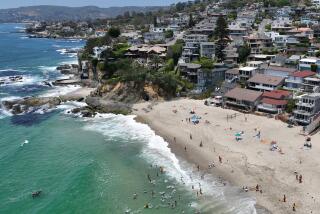Shore Footed : Riptides Plus Crowds Equal Trouble, but Swimmers Don’t Have to Go With the Flow
When school and the sun are both out, a lemming-like urge to bolt for the ocean grips Orange County residents by the hundreds of thousands.
Officially, the first day of summer was Friday. But lifeguards say the daily migration to the beaches began long before that--along with their work rescuing floundering bathers.
As the weather starts getting warmer and the typical June morning haze burns away in the summer heat, county lifeguards are girding for the beach population explosion and consequent increase in the number of rescues. Lifeguards say most of those rescues will be due to riptides, which often catch swimmers unaware and drag them far from shore.
“Probably 80% of our rescues are due to rip currents,” said Nick Cupaiuolo, a lifeguard supervisor at Huntington State Beach. During the summer, when riptides are especially strong, lifeguards there make as many as 200 rescues a day, he said.
Riptides, properly called rip currents because they are not actually tides, are caused when water flowing back to the ocean is blocked by incoming waves. The waves force the currents to flow sideways along the shore; eventually, the currents will flow into an underwater depression, which acts like a funnel and shoots the current back out to sea. The fast-moving water can shoot hundreds of feet out into the ocean, dragging swimmers with it, Cupaiuolo said.
“A few years ago, (a friend and) I got pulled out by a riptide,” said Huntington Beach resident Renee Turner, 17. “The lifeguards didn’t see us. It was so scary. After that I didn’t go into the water for a long time. I was just afraid.”
Turner’s experience was hardly unique. Riptides were the cause of about 1,500 of the 1,900 rescues reported at Huntington Beach in 1990, lifeguard John Barth said.
“Many were exhausted and may have drowned had we not been able to rescue them,” Barth said.
It’s not really the riptides that are deadly, Cupaiuolo said. It’s panic.
“The main problem is that people will panic because they’re going out to sea against their will,” he said. “It’s kind of scary for someone who doesn’t have much experience (swimming in the ocean). There’s no such thing as an undertow. A rip current is not going to pull you under the water.”
Panicky swimmers often struggle against the current and exhaust themselves instead of trying to swim out of it, Cupaiuolo said. The best way to escape a riptide, Cupaiuolo said, is to swim parallel to the beach, instead of directly toward it. The largest rip currents are seldom wider than 25 to 50 yards across.
“They can happen any time, but they’re much more predominant when the tide is going out, and when there’s bigger surf because there is going to be more water moving around. Once you know what to look for they’re very easy to see,” he said. For example, the water will be frothy and brown rather than green, and the flow of water back into the sea tends to flatten incoming waves.
Laguna Beach lifeguard supervisor Jeff Gilbert said rip currents there become stronger during the summer months and often carry small children away from the shore.
Rip currents “seem to be a magnet for them. That’s their little roller-coaster ride. They think it’s fun if they don’t get sucked out immediately. (But) there’s kind of a shocked look on their face when they get dragged out farther than where they can stand,” he said.
“My biggest problem is parents being unaware of where their kids are. We do the best we can, but (it’s not easy) when we’re watching 2,000 people at a stretch.”
Or perhaps more than 2,000 people. As the days get hotter, more sun worshipers head for the beach earlier and stay around later. So do the lifeguards.
“After Memorial Day, the crowds really start. This is typical June gloom, but within the next couple weekends we’ll start to see our normal summer beach crowd,” with about 20,000 to 30,000 beach-goers a day, Cupaiuolo said
Lifeguards said they want people to swim safely and within their limits, but they still encourage people to enjoy the beach. And it doesn’t take much encouragement.
On a recent Wednesday afternoon, Tim Nguyen, a 20-year-old UC Irvine sophomore, succumbed to the urge to hit the sand at Newport Beach: “I’m trying to study electrical engineering, but the beach has just been beckoning to me.”
Caught in the Current
Lifeguards say most of their beach rescues are due to riptides, a collision of currents that often catches swimmers off guard and drags them far from shore.
A. Water on the beach sometimes becomes trapped on shore by the incoming surf.
B. Instead of flowing back into the ocean, the water is forced sideways until it reaches a dip in the sea floor. The dip channels the water back into the sea, creating a fast-moving current that can extend up to 100 feet.
Spotting Rip Currents
* Water is frothy and brown instead of green.
* The riptide flattens incoming waves.
Escaping the Pull
1. Don’t panic
2. Swim parallel to the shore
3. Use swim fins
More to Read
Sign up for Essential California
The most important California stories and recommendations in your inbox every morning.
You may occasionally receive promotional content from the Los Angeles Times.










